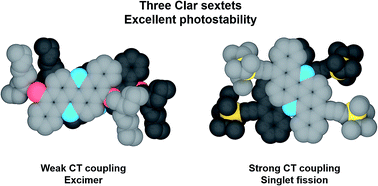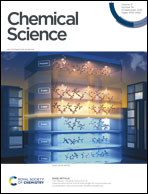Flavanthrene derivatives as photostable and efficient singlet exciton fission materials†
Abstract
Singlet exciton fission (SF) is believed to have the potential to break the Shockley–Queisser limit for third-generation solar cell devices, so it has attracted great attention. Conventional linear acene based SF materials generally suffer from low triplet energy and poor photostability. We report herein two flavanthrene derivatives, EH-Fla and TIPS-Fla, as new photostable singlet exciton fission materials. These N-doped two-dimensional angular fused acenes have three sets of aromatic Clar sextets, making them significantly more stable than linear acenes with only one sextet. Time-resolved spectroscopy characterization reveals that the SF process occurs in the polycrystalline films of EH-Fla and TIPS-Fla, with maximal triplet yields of 32% and 159%, respectively. The SF processes of these two molecules are mediated by excimer states. In EH-Fla, the low-lying excimer prevents the SF process from occurring effectively, resulting in a low triplet yield. In contrast, the excimer state in TIPS-Fla is mixed with strong CT coupling, which prompts efficient SF and results in a high triplet yield. Our results show that flavanthrene is a promising SF chromophore for photoenergy conversion applications, while a fine-tune of the intermolecular interaction is crucial for achieving high SF efficiency.

- This article is part of the themed collection: 2022 Chemical Science HOT Article Collection


 Please wait while we load your content...
Please wait while we load your content...